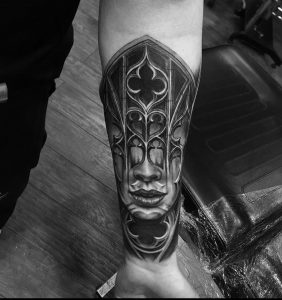What makes tattoo ink permanent?
The immune system has gotten a lot of press lately. Nor surprisingly, as a strong and healthy one will protect you from things like viruses. And, if you do catch one (not naming names), it can make sure you recover faster.
But your immune system and its response is also the reason why the ink in your tattoo becomes a permanent feature on or, actually in, your body. Let’s take a look at what happens when that needle hits your skin.
Has to get past the epidermis

Since we continuously shed our skin (about one million skin cells per day…) the tattoo artist must get the pigment deeper than that outermost layer, the epidermis, that gets shed and end up as, well, dust mostly. Otherwise the tattoo would flake off over time, and quite quickly.
Modern tattooing machines insert tiny needles into the second layer of the skin, the dermis, at a frequency of of 50 to 3,000 times per minute. This layer is composed of things such as collagen fibers, glands, blood vessels and nerves. Every time the needle penetrates, it causes a microscopic wound.
This causes your body’s immune system to rally to your defence and to treat the wound. Or, in the case of tattooing, several thousand wounds. It does so in a couple of general ways, one of them more important for the actual result.
Macrophages and fibroblasts

It sends white blood cells called macrophages to gobble up the invaders and foreign material and sacrifice themselves to keep you safe and protected against infection. Meaning they eat some of the ink. Some of them travel out through the lymph nodes, but some stay with nowhere to go and so does the ink inside them.
Some of the ink also remains suspended in the dermis, after being consumed by skin cells called fibroblasts. These are meant to repair and/or regenerate damaged tissue. Think of how a scar transforms from pink and soft to darker and more fibrous.
It takes about two weeks to one month for the epidermal layer to heal. During this time, ink could still escape from the dermis, which is why again we cannot stress the importance of after care enough!
The dermal cells remain in place until they die, and when they have completed their life span, they are absorbed by younger cells. This means that the ink travels from one generation of cells to the next, and so the tattoo remains in place. Although, not as static as it may appear…
Natural fading

Tattoos do naturally fade over time with this process, as macrophages continue to carry some of the pigment off. UV light can also break down the pigment of the ink so SPF, as high as you can go, at all times during sun exposure.
Of course, to begin with, ink also deposits itself in the outer layer of the skin. This is what peels off during the healing process, and why the skin coming off looks like thin sheets of black, or whatever colour your tattoo is. It is not your actual tattoo peeling off.
